Huawei H12-831_V1.0 Übungsprüfungen
Zuletzt aktualisiert am 05.09.2025- Prüfungscode: H12-831_V1.0
- Prüfungsname: HCIP-Datacom-Advanced Routing & Switching Technology V1.0
- Zertifizierungsanbieter: Huawei
- Zuletzt aktualisiert am: 05.09.2025
Although adjacency will be formed between routers of the same level on the same network segment of IS-IS in the broadcast network, that is, adjacency will be formed between all non- DIS routers, in the implementation of IS-IS and BFD linkage, BFD sessions are only established between DIS and non-DIS, and BFD sessions are not started between non-DIS.
- A . True
- B . False
In the network shown in the figure, the administrator first completes the routing configuration as shown in the options, and then enables MPLS and LDP functions on all devices and interconnected interfaces of R1-R3, so as to realize the traffic from PC1 to PC2 forwarding based on MPLS in the network.
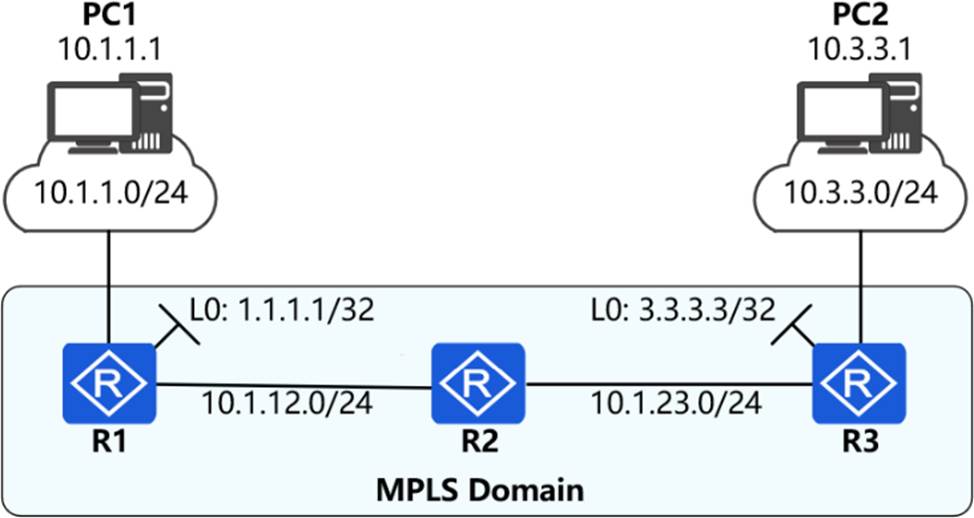
Which of the following routing configuration options can achieve this function?
- A . # R1
Bgp 65000
Router-id 1.1.1.1
Peer 3.3.3.3 as-number 65000
Peer 3.3.3.3 connect-interface LoopBack 0
network 10.1.1.0 24
# R3
Bgp 65000
Router-id 3.3.3.3
Peer 1.1.1.1 as-number 65000
Peer 1.1.1.1 connect-interface LoopBack 0
network 10.3.3.0 24 - B . # R1
ospf 1
Area 0
Network 1.1.1.10.0.0.0
Network 10.1.12.00.0.0.255
bgp 65000
Router-id 1.1.1.1
Peer 3.3.3.3 as-number 65000
Peer 3.3.3.3 connect-interface LoopBack 0
network 10.1.1.0 24
Ip ip-prefix 1 index 10 permit 10.3.3.0 24
route recursive-lookup tunnel ip-prefix 1
# R2
ospf 1
Area 0
Network 2.2.2.20.0.0.0
Network 10.1.12.00.0.0.255
Network 10.1.23.00.0.0.255
# R3
ospf 1
Area 0
Network 3.3.3.30.0.0.0
Network 10.1.23.00.0.0.255bgp 65000
Router-id 3.3.3.3
Peer 1.1.1.1 as-number 65000
Peer 1.1.1.1 connect-interface LoopBack 0
Network 10.3.3.024
Ip ip-prefix 1 index 10 permit 10.1.1.0 24
route recursive-lookup tunnel ip-prefix 1 - C . # R1
ospf 1
Area 0
Network 1.1.1.10.0.0.0
Network 10.1.12.00.0.0.255
Network 10.1.1.00.0.0.255
# ospf 1
Area 0
Network 2.2.2.20.0.0.0
Network 10.1.12.00.0.0.255
Network 10.1.23.00.0.0.255
# R3
ospf 1
Area 0
Network 3.3.3.30.0.0.0
Network 10.1.23.00.0.0.255
Network 10.3.3.00.0.0.255 - D . # R1
ospf 1
Area 0
Network 1.1.1.10.0.0.0
Network 10.1.12.00.0.0.255
# R2
ospf 1
Area 0
Network 2.2.2.20.0.0.0
Network 10.1.12.00.0.0.255
Network 10.1.23.00.0.0.255
# R3
ospf 1
Area 0
Network 3.3.3.30.0.0.0
Network 10.1.23.00.0.0.255
As shown in the figure, an administrator has enabled the port isolation function on the interface of the switch connected to the terminal. In this scenario, which of the following IP addresses cannot be pinged by PC1?
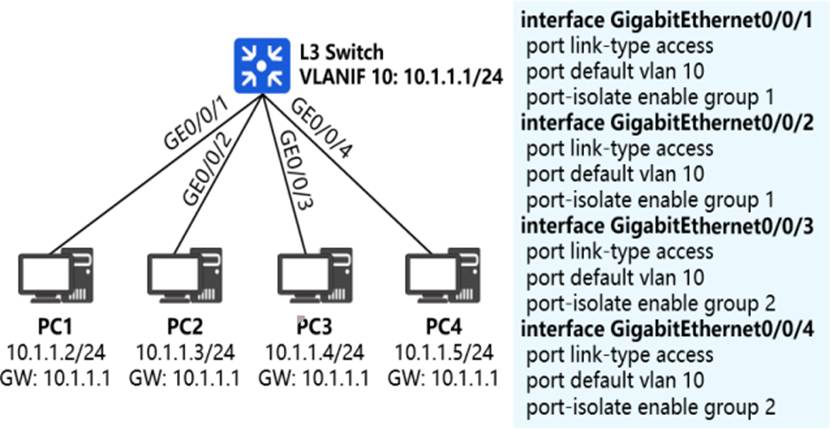
- A . 10.1.1.3
- B . 10.1.1.5
- C . 10.1.1.1
- D . 10.1.1.4
In the IS-IS network shown in the figure, R1 introduces the default route through the "default-route-advertise always level-1" command. Which of the following descriptions are correct? (Multiple choice)
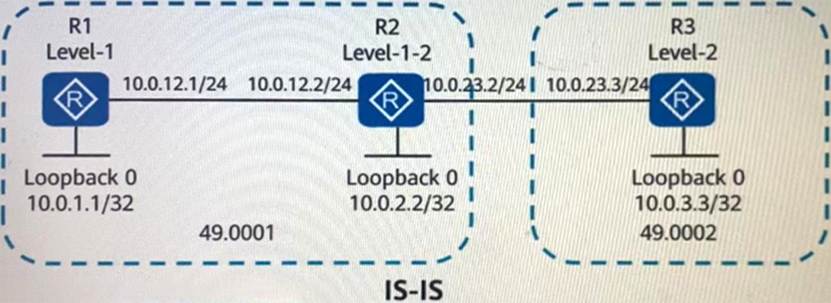
- A . 10.0.12.2 can ping 10.0.3.3
- B . 10.0.1.1 can ping 10.0.2.2
- C . 10.0.1.1 can ping 10.0.3.3
- D . 10.0.2.2 can ping 10.0.3.3
In the OSPF network shown in the figure, Area 1 and Area 2 are both common areas, and R4 introduces the external route 10.0.4.4/32.
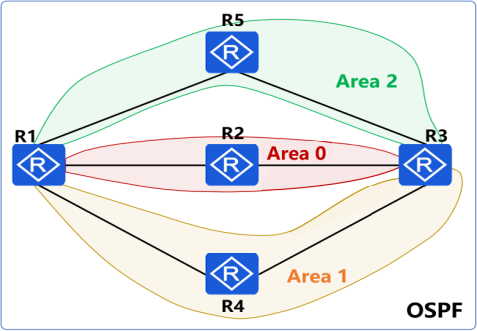
The "asbr-summary 10.0.4.0 255.255.255.0" command is configured in the OSPF processes of R1 and R3. Which of the following routers have a route entry for 10.0.4.4/32 in their routing tables? (Multiple choice)
- A . R1
- B . R2
- C . R5
- D . R3
The Router ID of R4 is 10.0.4.4. In the LSDB of R4, the LSA shown in the figure is seen. The network engineer makes the following inferences based on the LSA. Which one is wrong?

- A . This LSA is generated by R4
- B . R4 has two OSPFv3 neighbors
- C . R4 is the DR on both links
- D . R4 does not support importing external routes into OSPFv3
Which of the following is not a new addition to IS-IS to support the processing and calculation of IPv6 routes?
- A . TLV 232: It is equivalent to the "IP Interface Address" TLV in IPv4, except that the original 32-bit IPv4 address is changed to a 128-bit IPv6 address
- B . The source IP address of the IS-IS Hello message is changed to the link-local address
- C . TLV 236: describes the reachability of the network by defining routing information prefix, metric value and other information
- D . When publishing IPv6 routes, the MLFID value must be included
In the network shown in the figure, adjacent routers use directly connected interfaces to establish EBGP neighbor relationships. The Router ID of each device is 10.0.XX, and the AS number is 6500X, where X is the router number. R1 and R4 both have static routes to 192.168.1.0/24, which are introduced into BGP through import.
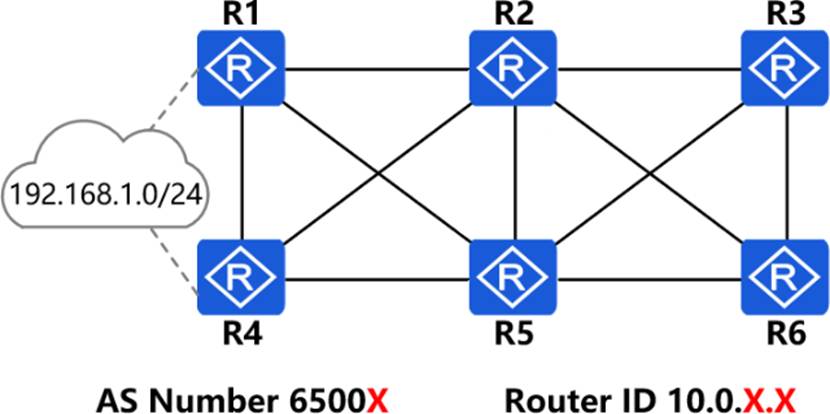
If the "ageregate 192.168.1.016 detail-suppresed command" is configured on R1, which of the following is the traffic path from R3 to 192.168.1.0/24?
- A . R3-R2-R1
- B . R3-R5-R1
- C . RЗ-R6-R5-R1
- D . R3-R5-R4
With the increase of business traffic, an enterprise needs to expand the dedicated transmission bandwidth of the backbone network. Which of the following methods can best meet this demand?
- A . Increase the number of tunnels between backbone network devices and enable HSB protection for these tunnels.
- B . Increase the number of interconnected links between backbone network devices and deploy link aggregation between backbone network devices
- C . Modify the routing protocols related to the network layer and change the number of paths for routing protocol load sharing to the maximum value
- D . Add a high-performance forwarding switch and connect the original directly connected ports of the backbone network to the same switch
Each OSPFv3 router generates a Link-LSA for each link, describing information such as the link-local address, IPv6 prefix address, and interface number on this link, and provides link options to be set in the Network-LSA, which is only propagated within this link.
- A . True
- B . False
